Causes and Risk Factors of Skin Cancer
VerifiedAdded on 2019/12/03
|26
|7987
|142
Report
AI Summary
This report investigates the causes and risk factors of skin cancer in the UK. It begins by outlining the increasing incidence of skin cancer in the UK, citing statistics on new cases and mortality rates. The report then delves into a literature review, examining various studies on the causes of skin cancer, including sun exposure (UV radiation), exposure to polycyclic aromatic hydrocarbons (PAHs), ionizing radiation, and arsenic exposure. Risk factors such as fair skin, lifestyle choices, ozone depletion, and genetics are also discussed. The methodology section details the use of secondary data from published research and the qualitative thematic analysis employed. The data analysis section presents findings from the literature review, highlighting the prevalence of skin cancer in England, the higher risk for fair-skinned individuals and males, and the increased incidence among organ transplant recipients and AIDS patients. The report concludes by recommending sun protection, public awareness campaigns, early detection, development of improved sun protection agents, and avoidance of tanning beds. Finally, it suggests areas for future research, such as focusing on specific causes like ionizing radiation and arsenic's role in skin cancer development.

TO ANALYZE CAUSES AND RISK FACTORS OF SKIN CANCER
Paraphrase This Document
Need a fresh take? Get an instant paraphrase of this document with our AI Paraphraser
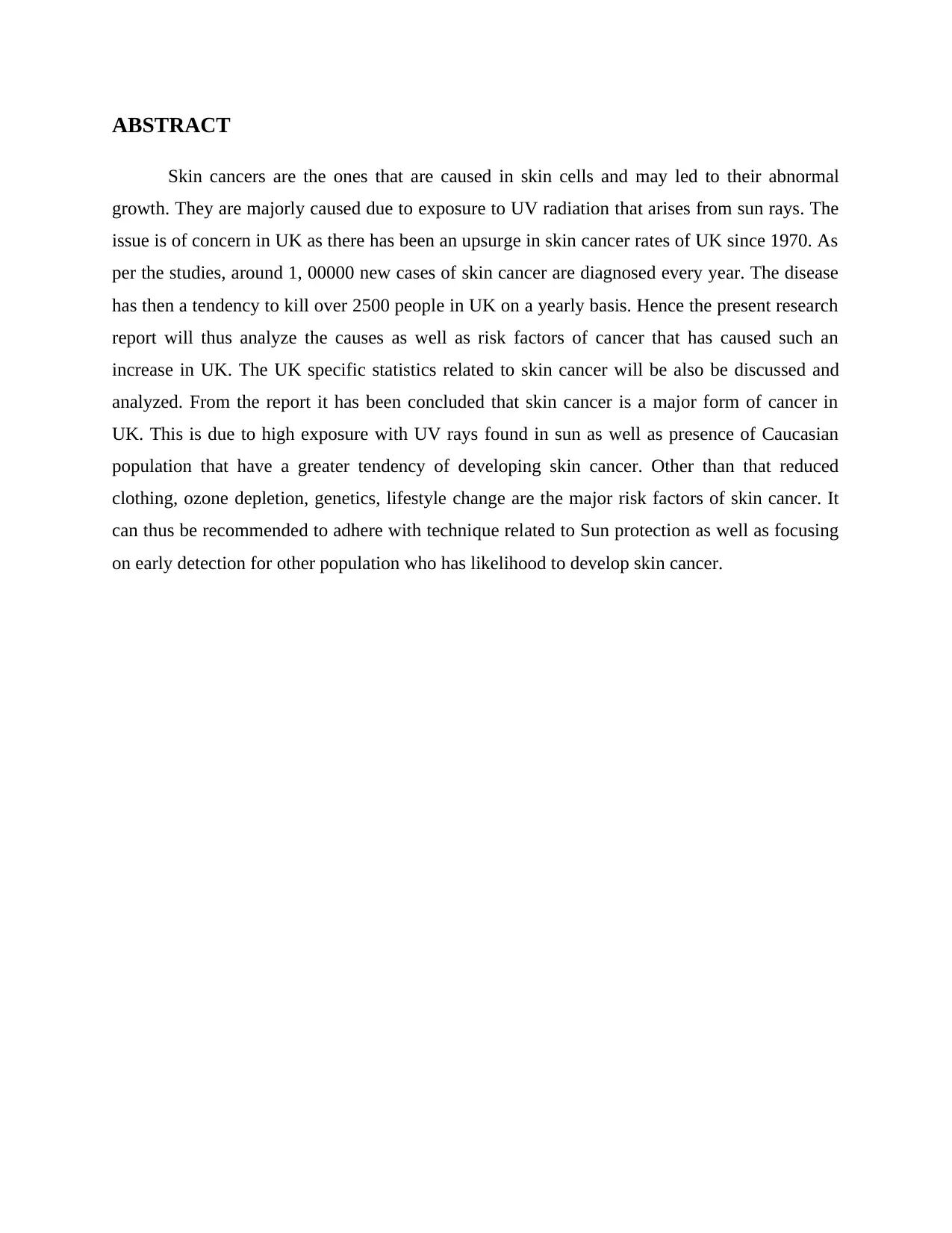
ABSTRACT
Skin cancers are the ones that are caused in skin cells and may led to their abnormal
growth. They are majorly caused due to exposure to UV radiation that arises from sun rays. The
issue is of concern in UK as there has been an upsurge in skin cancer rates of UK since 1970. As
per the studies, around 1, 00000 new cases of skin cancer are diagnosed every year. The disease
has then a tendency to kill over 2500 people in UK on a yearly basis. Hence the present research
report will thus analyze the causes as well as risk factors of cancer that has caused such an
increase in UK. The UK specific statistics related to skin cancer will be also be discussed and
analyzed. From the report it has been concluded that skin cancer is a major form of cancer in
UK. This is due to high exposure with UV rays found in sun as well as presence of Caucasian
population that have a greater tendency of developing skin cancer. Other than that reduced
clothing, ozone depletion, genetics, lifestyle change are the major risk factors of skin cancer. It
can thus be recommended to adhere with technique related to Sun protection as well as focusing
on early detection for other population who has likelihood to develop skin cancer.
Skin cancers are the ones that are caused in skin cells and may led to their abnormal
growth. They are majorly caused due to exposure to UV radiation that arises from sun rays. The
issue is of concern in UK as there has been an upsurge in skin cancer rates of UK since 1970. As
per the studies, around 1, 00000 new cases of skin cancer are diagnosed every year. The disease
has then a tendency to kill over 2500 people in UK on a yearly basis. Hence the present research
report will thus analyze the causes as well as risk factors of cancer that has caused such an
increase in UK. The UK specific statistics related to skin cancer will be also be discussed and
analyzed. From the report it has been concluded that skin cancer is a major form of cancer in
UK. This is due to high exposure with UV rays found in sun as well as presence of Caucasian
population that have a greater tendency of developing skin cancer. Other than that reduced
clothing, ozone depletion, genetics, lifestyle change are the major risk factors of skin cancer. It
can thus be recommended to adhere with technique related to Sun protection as well as focusing
on early detection for other population who has likelihood to develop skin cancer.

ACKNOWLEDGEMENTS
⊘ This is a preview!⊘
Do you want full access?
Subscribe today to unlock all pages.

Trusted by 1+ million students worldwide
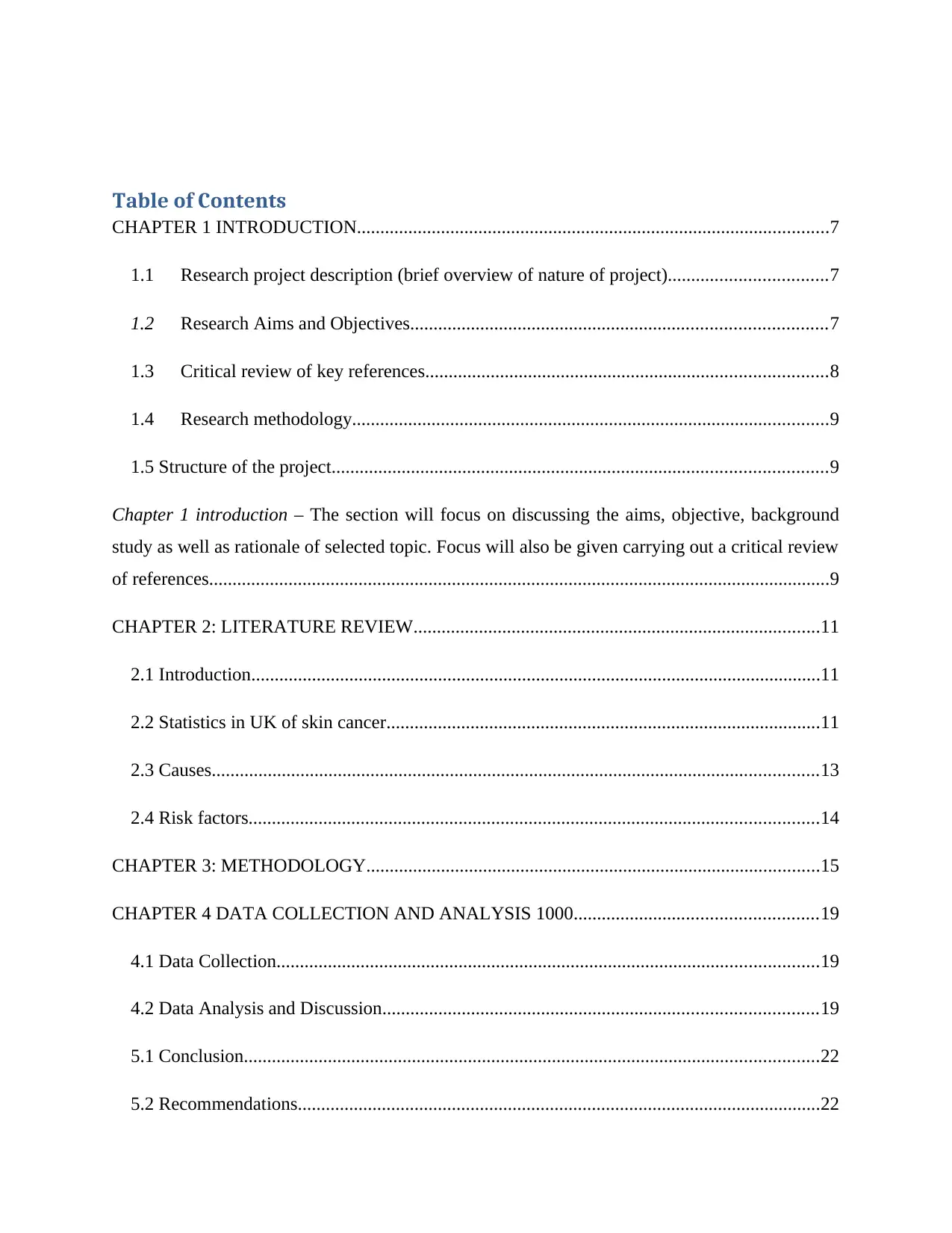
Table of Contents
CHAPTER 1 INTRODUCTION.....................................................................................................7
1.1 Research project description (brief overview of nature of project)..................................7
1.2 Research Aims and Objectives.........................................................................................7
1.3 Critical review of key references......................................................................................8
1.4 Research methodology......................................................................................................9
1.5 Structure of the project..........................................................................................................9
Chapter 1 introduction – The section will focus on discussing the aims, objective, background
study as well as rationale of selected topic. Focus will also be given carrying out a critical review
of references.....................................................................................................................................9
CHAPTER 2: LITERATURE REVIEW.......................................................................................11
2.1 Introduction..........................................................................................................................11
2.2 Statistics in UK of skin cancer.............................................................................................11
2.3 Causes..................................................................................................................................13
2.4 Risk factors..........................................................................................................................14
CHAPTER 3: METHODOLOGY.................................................................................................15
CHAPTER 4 DATA COLLECTION AND ANALYSIS 1000....................................................19
4.1 Data Collection....................................................................................................................19
4.2 Data Analysis and Discussion.............................................................................................19
5.1 Conclusion...........................................................................................................................22
5.2 Recommendations................................................................................................................22
CHAPTER 1 INTRODUCTION.....................................................................................................7
1.1 Research project description (brief overview of nature of project)..................................7
1.2 Research Aims and Objectives.........................................................................................7
1.3 Critical review of key references......................................................................................8
1.4 Research methodology......................................................................................................9
1.5 Structure of the project..........................................................................................................9
Chapter 1 introduction – The section will focus on discussing the aims, objective, background
study as well as rationale of selected topic. Focus will also be given carrying out a critical review
of references.....................................................................................................................................9
CHAPTER 2: LITERATURE REVIEW.......................................................................................11
2.1 Introduction..........................................................................................................................11
2.2 Statistics in UK of skin cancer.............................................................................................11
2.3 Causes..................................................................................................................................13
2.4 Risk factors..........................................................................................................................14
CHAPTER 3: METHODOLOGY.................................................................................................15
CHAPTER 4 DATA COLLECTION AND ANALYSIS 1000....................................................19
4.1 Data Collection....................................................................................................................19
4.2 Data Analysis and Discussion.............................................................................................19
5.1 Conclusion...........................................................................................................................22
5.2 Recommendations................................................................................................................22
Paraphrase This Document
Need a fresh take? Get an instant paraphrase of this document with our AI Paraphraser
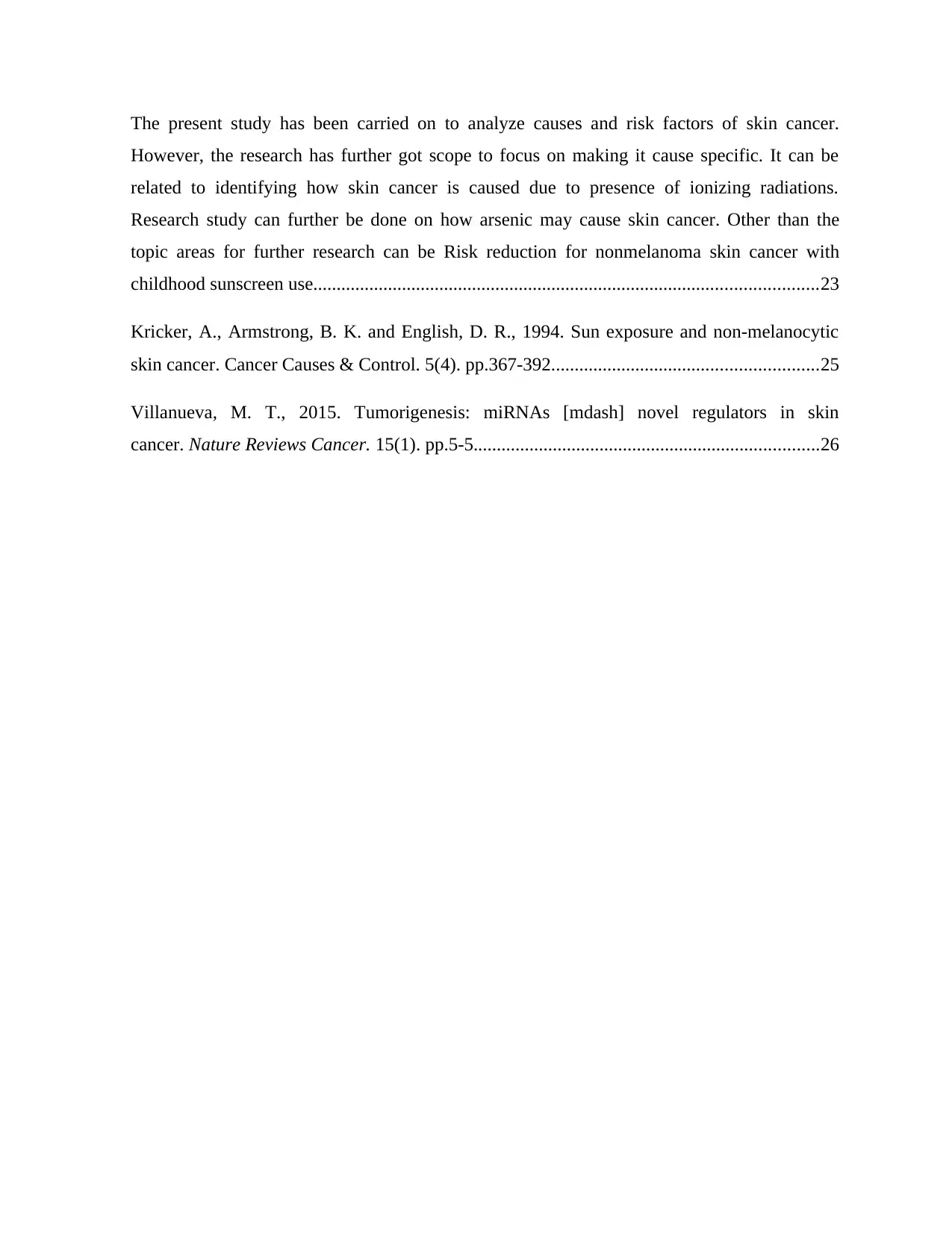
The present study has been carried on to analyze causes and risk factors of skin cancer.
However, the research has further got scope to focus on making it cause specific. It can be
related to identifying how skin cancer is caused due to presence of ionizing radiations.
Research study can further be done on how arsenic may cause skin cancer. Other than the
topic areas for further research can be Risk reduction for nonmelanoma skin cancer with
childhood sunscreen use............................................................................................................23
Kricker, A., Armstrong, B. K. and English, D. R., 1994. Sun exposure and non-melanocytic
skin cancer. Cancer Causes & Control. 5(4). pp.367-392.........................................................25
Villanueva, M. T., 2015. Tumorigenesis: miRNAs [mdash] novel regulators in skin
cancer. Nature Reviews Cancer. 15(1). pp.5-5..........................................................................26
However, the research has further got scope to focus on making it cause specific. It can be
related to identifying how skin cancer is caused due to presence of ionizing radiations.
Research study can further be done on how arsenic may cause skin cancer. Other than the
topic areas for further research can be Risk reduction for nonmelanoma skin cancer with
childhood sunscreen use............................................................................................................23
Kricker, A., Armstrong, B. K. and English, D. R., 1994. Sun exposure and non-melanocytic
skin cancer. Cancer Causes & Control. 5(4). pp.367-392.........................................................25
Villanueva, M. T., 2015. Tumorigenesis: miRNAs [mdash] novel regulators in skin
cancer. Nature Reviews Cancer. 15(1). pp.5-5..........................................................................26
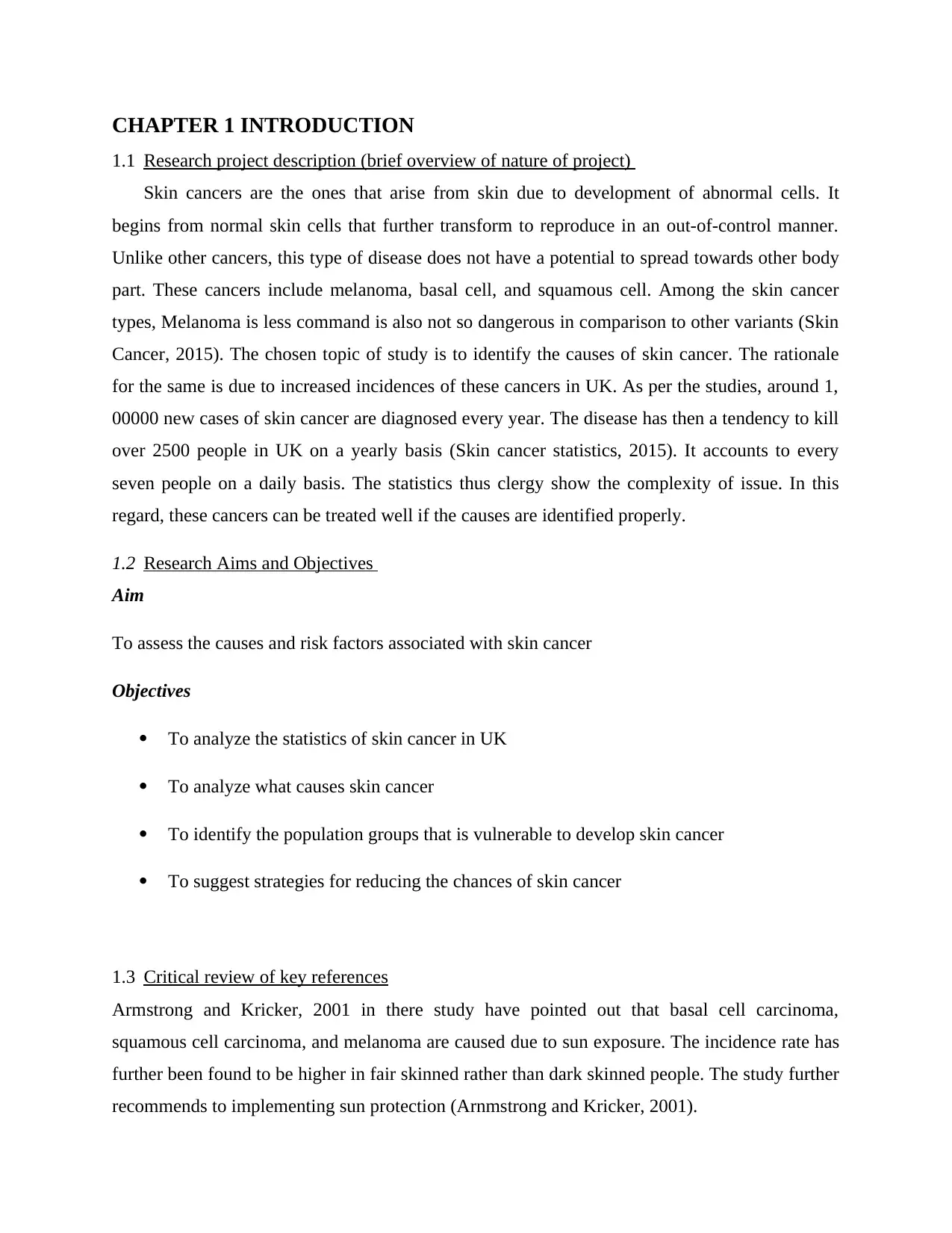
CHAPTER 1 INTRODUCTION
1.1 Research project description (brief overview of nature of project)
Skin cancers are the ones that arise from skin due to development of abnormal cells. It
begins from normal skin cells that further transform to reproduce in an out-of-control manner.
Unlike other cancers, this type of disease does not have a potential to spread towards other body
part. These cancers include melanoma, basal cell, and squamous cell. Among the skin cancer
types, Melanoma is less command is also not so dangerous in comparison to other variants (Skin
Cancer, 2015). The chosen topic of study is to identify the causes of skin cancer. The rationale
for the same is due to increased incidences of these cancers in UK. As per the studies, around 1,
00000 new cases of skin cancer are diagnosed every year. The disease has then a tendency to kill
over 2500 people in UK on a yearly basis (Skin cancer statistics, 2015). It accounts to every
seven people on a daily basis. The statistics thus clergy show the complexity of issue. In this
regard, these cancers can be treated well if the causes are identified properly.
1.2 Research Aims and Objectives
Aim
To assess the causes and risk factors associated with skin cancer
Objectives
To analyze the statistics of skin cancer in UK
To analyze what causes skin cancer
To identify the population groups that is vulnerable to develop skin cancer
To suggest strategies for reducing the chances of skin cancer
1.3 Critical review of key references
Armstrong and Kricker, 2001 in there study have pointed out that basal cell carcinoma,
squamous cell carcinoma, and melanoma are caused due to sun exposure. The incidence rate has
further been found to be higher in fair skinned rather than dark skinned people. The study further
recommends to implementing sun protection (Arnmstrong and Kricker, 2001).
1.1 Research project description (brief overview of nature of project)
Skin cancers are the ones that arise from skin due to development of abnormal cells. It
begins from normal skin cells that further transform to reproduce in an out-of-control manner.
Unlike other cancers, this type of disease does not have a potential to spread towards other body
part. These cancers include melanoma, basal cell, and squamous cell. Among the skin cancer
types, Melanoma is less command is also not so dangerous in comparison to other variants (Skin
Cancer, 2015). The chosen topic of study is to identify the causes of skin cancer. The rationale
for the same is due to increased incidences of these cancers in UK. As per the studies, around 1,
00000 new cases of skin cancer are diagnosed every year. The disease has then a tendency to kill
over 2500 people in UK on a yearly basis (Skin cancer statistics, 2015). It accounts to every
seven people on a daily basis. The statistics thus clergy show the complexity of issue. In this
regard, these cancers can be treated well if the causes are identified properly.
1.2 Research Aims and Objectives
Aim
To assess the causes and risk factors associated with skin cancer
Objectives
To analyze the statistics of skin cancer in UK
To analyze what causes skin cancer
To identify the population groups that is vulnerable to develop skin cancer
To suggest strategies for reducing the chances of skin cancer
1.3 Critical review of key references
Armstrong and Kricker, 2001 in there study have pointed out that basal cell carcinoma,
squamous cell carcinoma, and melanoma are caused due to sun exposure. The incidence rate has
further been found to be higher in fair skinned rather than dark skinned people. The study further
recommends to implementing sun protection (Arnmstrong and Kricker, 2001).
⊘ This is a preview!⊘
Do you want full access?
Subscribe today to unlock all pages.

Trusted by 1+ million students worldwide
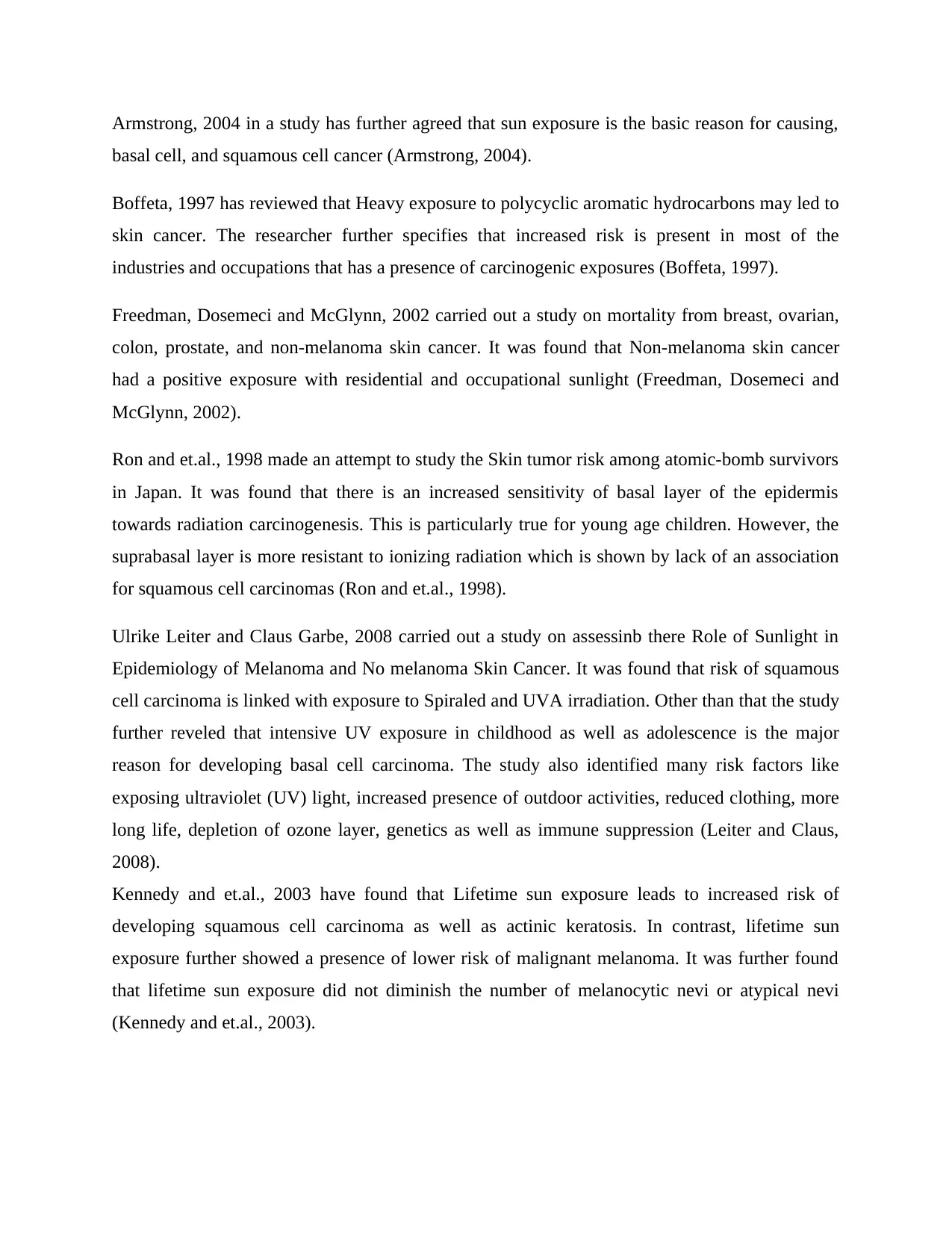
Armstrong, 2004 in a study has further agreed that sun exposure is the basic reason for causing,
basal cell, and squamous cell cancer (Armstrong, 2004).
Boffeta, 1997 has reviewed that Heavy exposure to polycyclic aromatic hydrocarbons may led to
skin cancer. The researcher further specifies that increased risk is present in most of the
industries and occupations that has a presence of carcinogenic exposures (Boffeta, 1997).
Freedman, Dosemeci and McGlynn, 2002 carried out a study on mortality from breast, ovarian,
colon, prostate, and non-melanoma skin cancer. It was found that Non-melanoma skin cancer
had a positive exposure with residential and occupational sunlight (Freedman, Dosemeci and
McGlynn, 2002).
Ron and et.al., 1998 made an attempt to study the Skin tumor risk among atomic-bomb survivors
in Japan. It was found that there is an increased sensitivity of basal layer of the epidermis
towards radiation carcinogenesis. This is particularly true for young age children. However, the
suprabasal layer is more resistant to ionizing radiation which is shown by lack of an association
for squamous cell carcinomas (Ron and et.al., 1998).
Ulrike Leiter and Claus Garbe, 2008 carried out a study on assessinb there Role of Sunlight in
Epidemiology of Melanoma and No melanoma Skin Cancer. It was found that risk of squamous
cell carcinoma is linked with exposure to Spiraled and UVA irradiation. Other than that the study
further reveled that intensive UV exposure in childhood as well as adolescence is the major
reason for developing basal cell carcinoma. The study also identified many risk factors like
exposing ultraviolet (UV) light, increased presence of outdoor activities, reduced clothing, more
long life, depletion of ozone layer, genetics as well as immune suppression (Leiter and Claus,
2008).
Kennedy and et.al., 2003 have found that Lifetime sun exposure leads to increased risk of
developing squamous cell carcinoma as well as actinic keratosis. In contrast, lifetime sun
exposure further showed a presence of lower risk of malignant melanoma. It was further found
that lifetime sun exposure did not diminish the number of melanocytic nevi or atypical nevi
(Kennedy and et.al., 2003).
basal cell, and squamous cell cancer (Armstrong, 2004).
Boffeta, 1997 has reviewed that Heavy exposure to polycyclic aromatic hydrocarbons may led to
skin cancer. The researcher further specifies that increased risk is present in most of the
industries and occupations that has a presence of carcinogenic exposures (Boffeta, 1997).
Freedman, Dosemeci and McGlynn, 2002 carried out a study on mortality from breast, ovarian,
colon, prostate, and non-melanoma skin cancer. It was found that Non-melanoma skin cancer
had a positive exposure with residential and occupational sunlight (Freedman, Dosemeci and
McGlynn, 2002).
Ron and et.al., 1998 made an attempt to study the Skin tumor risk among atomic-bomb survivors
in Japan. It was found that there is an increased sensitivity of basal layer of the epidermis
towards radiation carcinogenesis. This is particularly true for young age children. However, the
suprabasal layer is more resistant to ionizing radiation which is shown by lack of an association
for squamous cell carcinomas (Ron and et.al., 1998).
Ulrike Leiter and Claus Garbe, 2008 carried out a study on assessinb there Role of Sunlight in
Epidemiology of Melanoma and No melanoma Skin Cancer. It was found that risk of squamous
cell carcinoma is linked with exposure to Spiraled and UVA irradiation. Other than that the study
further reveled that intensive UV exposure in childhood as well as adolescence is the major
reason for developing basal cell carcinoma. The study also identified many risk factors like
exposing ultraviolet (UV) light, increased presence of outdoor activities, reduced clothing, more
long life, depletion of ozone layer, genetics as well as immune suppression (Leiter and Claus,
2008).
Kennedy and et.al., 2003 have found that Lifetime sun exposure leads to increased risk of
developing squamous cell carcinoma as well as actinic keratosis. In contrast, lifetime sun
exposure further showed a presence of lower risk of malignant melanoma. It was further found
that lifetime sun exposure did not diminish the number of melanocytic nevi or atypical nevi
(Kennedy and et.al., 2003).
Paraphrase This Document
Need a fresh take? Get an instant paraphrase of this document with our AI Paraphraser
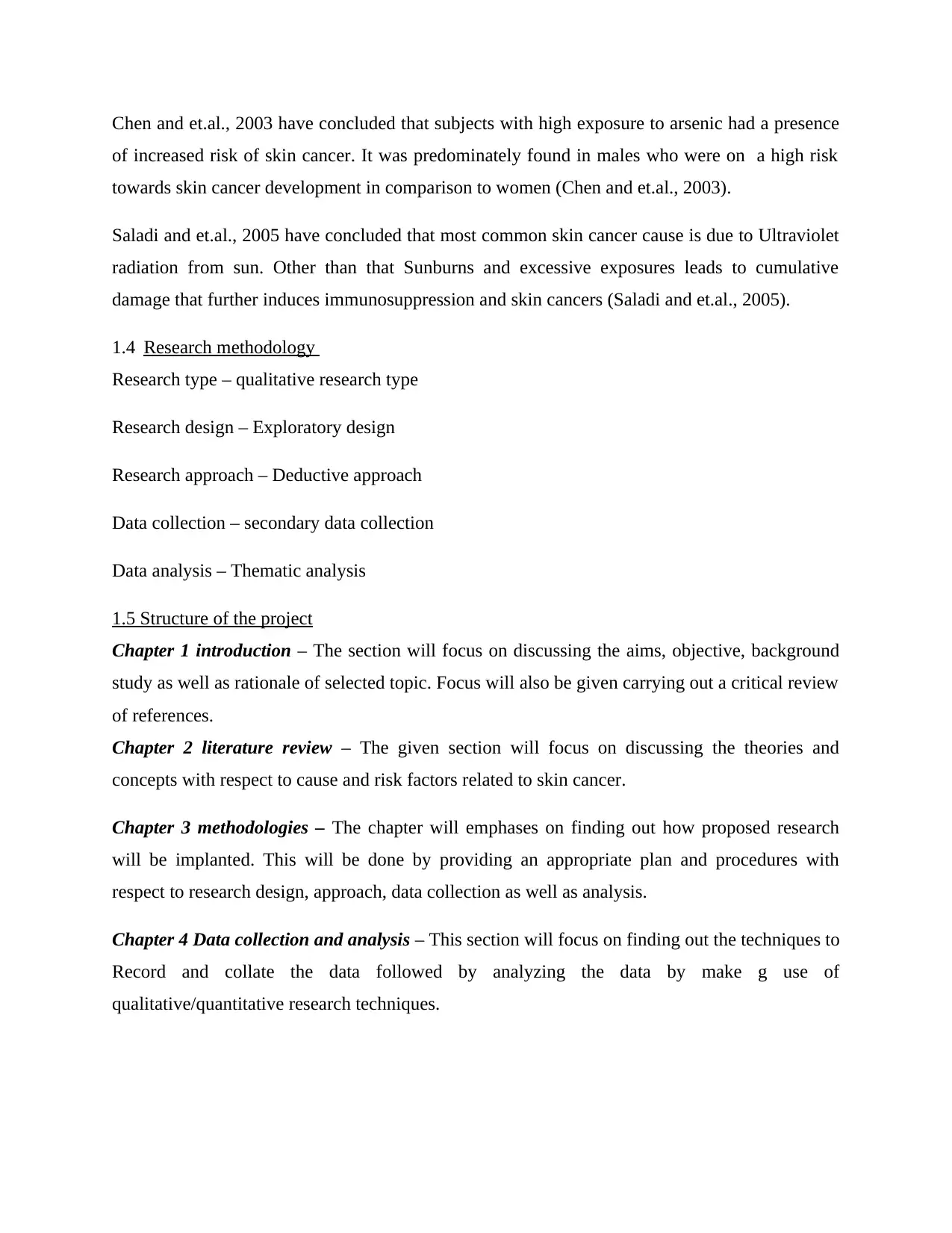
Chen and et.al., 2003 have concluded that subjects with high exposure to arsenic had a presence
of increased risk of skin cancer. It was predominately found in males who were on a high risk
towards skin cancer development in comparison to women (Chen and et.al., 2003).
Saladi and et.al., 2005 have concluded that most common skin cancer cause is due to Ultraviolet
radiation from sun. Other than that Sunburns and excessive exposures leads to cumulative
damage that further induces immunosuppression and skin cancers (Saladi and et.al., 2005).
1.4 Research methodology
Research type – qualitative research type
Research design – Exploratory design
Research approach – Deductive approach
Data collection – secondary data collection
Data analysis – Thematic analysis
1.5 Structure of the project
Chapter 1 introduction – The section will focus on discussing the aims, objective, background
study as well as rationale of selected topic. Focus will also be given carrying out a critical review
of references.
Chapter 2 literature review – The given section will focus on discussing the theories and
concepts with respect to cause and risk factors related to skin cancer.
Chapter 3 methodologies – The chapter will emphases on finding out how proposed research
will be implanted. This will be done by providing an appropriate plan and procedures with
respect to research design, approach, data collection as well as analysis.
Chapter 4 Data collection and analysis – This section will focus on finding out the techniques to
Record and collate the data followed by analyzing the data by make g use of
qualitative/quantitative research techniques.
of increased risk of skin cancer. It was predominately found in males who were on a high risk
towards skin cancer development in comparison to women (Chen and et.al., 2003).
Saladi and et.al., 2005 have concluded that most common skin cancer cause is due to Ultraviolet
radiation from sun. Other than that Sunburns and excessive exposures leads to cumulative
damage that further induces immunosuppression and skin cancers (Saladi and et.al., 2005).
1.4 Research methodology
Research type – qualitative research type
Research design – Exploratory design
Research approach – Deductive approach
Data collection – secondary data collection
Data analysis – Thematic analysis
1.5 Structure of the project
Chapter 1 introduction – The section will focus on discussing the aims, objective, background
study as well as rationale of selected topic. Focus will also be given carrying out a critical review
of references.
Chapter 2 literature review – The given section will focus on discussing the theories and
concepts with respect to cause and risk factors related to skin cancer.
Chapter 3 methodologies – The chapter will emphases on finding out how proposed research
will be implanted. This will be done by providing an appropriate plan and procedures with
respect to research design, approach, data collection as well as analysis.
Chapter 4 Data collection and analysis – This section will focus on finding out the techniques to
Record and collate the data followed by analyzing the data by make g use of
qualitative/quantitative research techniques.

Chapter 5 Conclusions and recommendation - The chapter will emphasize on concluding the
study followed by making recommendations so as to solve the issue of skin cancer. The areas of
further consideration will also be discussed.
study followed by making recommendations so as to solve the issue of skin cancer. The areas of
further consideration will also be discussed.
⊘ This is a preview!⊘
Do you want full access?
Subscribe today to unlock all pages.

Trusted by 1+ million students worldwide
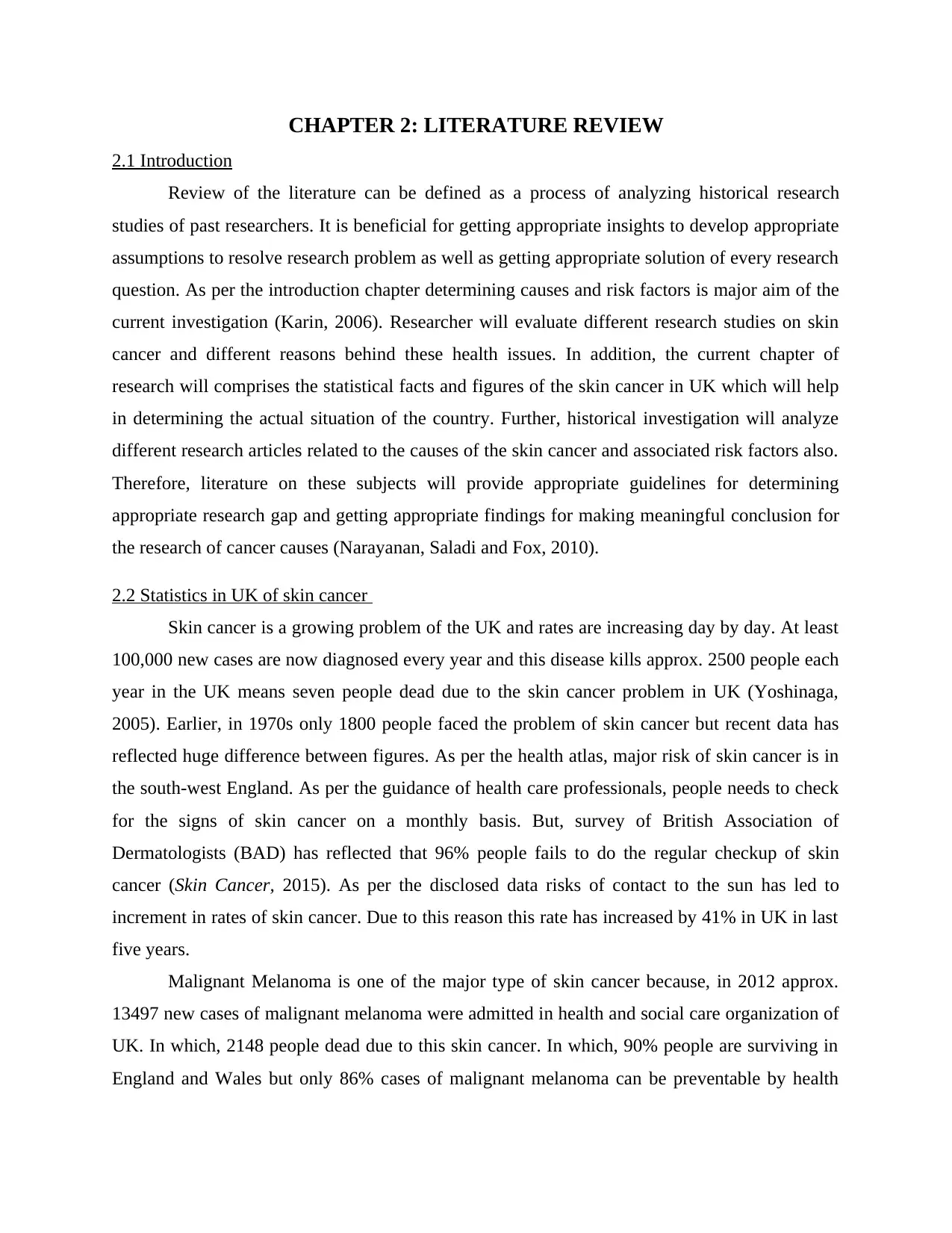
CHAPTER 2: LITERATURE REVIEW
2.1 Introduction
Review of the literature can be defined as a process of analyzing historical research
studies of past researchers. It is beneficial for getting appropriate insights to develop appropriate
assumptions to resolve research problem as well as getting appropriate solution of every research
question. As per the introduction chapter determining causes and risk factors is major aim of the
current investigation (Karin, 2006). Researcher will evaluate different research studies on skin
cancer and different reasons behind these health issues. In addition, the current chapter of
research will comprises the statistical facts and figures of the skin cancer in UK which will help
in determining the actual situation of the country. Further, historical investigation will analyze
different research articles related to the causes of the skin cancer and associated risk factors also.
Therefore, literature on these subjects will provide appropriate guidelines for determining
appropriate research gap and getting appropriate findings for making meaningful conclusion for
the research of cancer causes (Narayanan, Saladi and Fox, 2010).
2.2 Statistics in UK of skin cancer
Skin cancer is a growing problem of the UK and rates are increasing day by day. At least
100,000 new cases are now diagnosed every year and this disease kills approx. 2500 people each
year in the UK means seven people dead due to the skin cancer problem in UK (Yoshinaga,
2005). Earlier, in 1970s only 1800 people faced the problem of skin cancer but recent data has
reflected huge difference between figures. As per the health atlas, major risk of skin cancer is in
the south-west England. As per the guidance of health care professionals, people needs to check
for the signs of skin cancer on a monthly basis. But, survey of British Association of
Dermatologists (BAD) has reflected that 96% people fails to do the regular checkup of skin
cancer (Skin Cancer, 2015). As per the disclosed data risks of contact to the sun has led to
increment in rates of skin cancer. Due to this reason this rate has increased by 41% in UK in last
five years.
Malignant Melanoma is one of the major type of skin cancer because, in 2012 approx.
13497 new cases of malignant melanoma were admitted in health and social care organization of
UK. In which, 2148 people dead due to this skin cancer. In which, 90% people are surviving in
England and Wales but only 86% cases of malignant melanoma can be preventable by health
2.1 Introduction
Review of the literature can be defined as a process of analyzing historical research
studies of past researchers. It is beneficial for getting appropriate insights to develop appropriate
assumptions to resolve research problem as well as getting appropriate solution of every research
question. As per the introduction chapter determining causes and risk factors is major aim of the
current investigation (Karin, 2006). Researcher will evaluate different research studies on skin
cancer and different reasons behind these health issues. In addition, the current chapter of
research will comprises the statistical facts and figures of the skin cancer in UK which will help
in determining the actual situation of the country. Further, historical investigation will analyze
different research articles related to the causes of the skin cancer and associated risk factors also.
Therefore, literature on these subjects will provide appropriate guidelines for determining
appropriate research gap and getting appropriate findings for making meaningful conclusion for
the research of cancer causes (Narayanan, Saladi and Fox, 2010).
2.2 Statistics in UK of skin cancer
Skin cancer is a growing problem of the UK and rates are increasing day by day. At least
100,000 new cases are now diagnosed every year and this disease kills approx. 2500 people each
year in the UK means seven people dead due to the skin cancer problem in UK (Yoshinaga,
2005). Earlier, in 1970s only 1800 people faced the problem of skin cancer but recent data has
reflected huge difference between figures. As per the health atlas, major risk of skin cancer is in
the south-west England. As per the guidance of health care professionals, people needs to check
for the signs of skin cancer on a monthly basis. But, survey of British Association of
Dermatologists (BAD) has reflected that 96% people fails to do the regular checkup of skin
cancer (Skin Cancer, 2015). As per the disclosed data risks of contact to the sun has led to
increment in rates of skin cancer. Due to this reason this rate has increased by 41% in UK in last
five years.
Malignant Melanoma is one of the major type of skin cancer because, in 2012 approx.
13497 new cases of malignant melanoma were admitted in health and social care organization of
UK. In which, 2148 people dead due to this skin cancer. In which, 90% people are surviving in
England and Wales but only 86% cases of malignant melanoma can be preventable by health
Paraphrase This Document
Need a fresh take? Get an instant paraphrase of this document with our AI Paraphraser
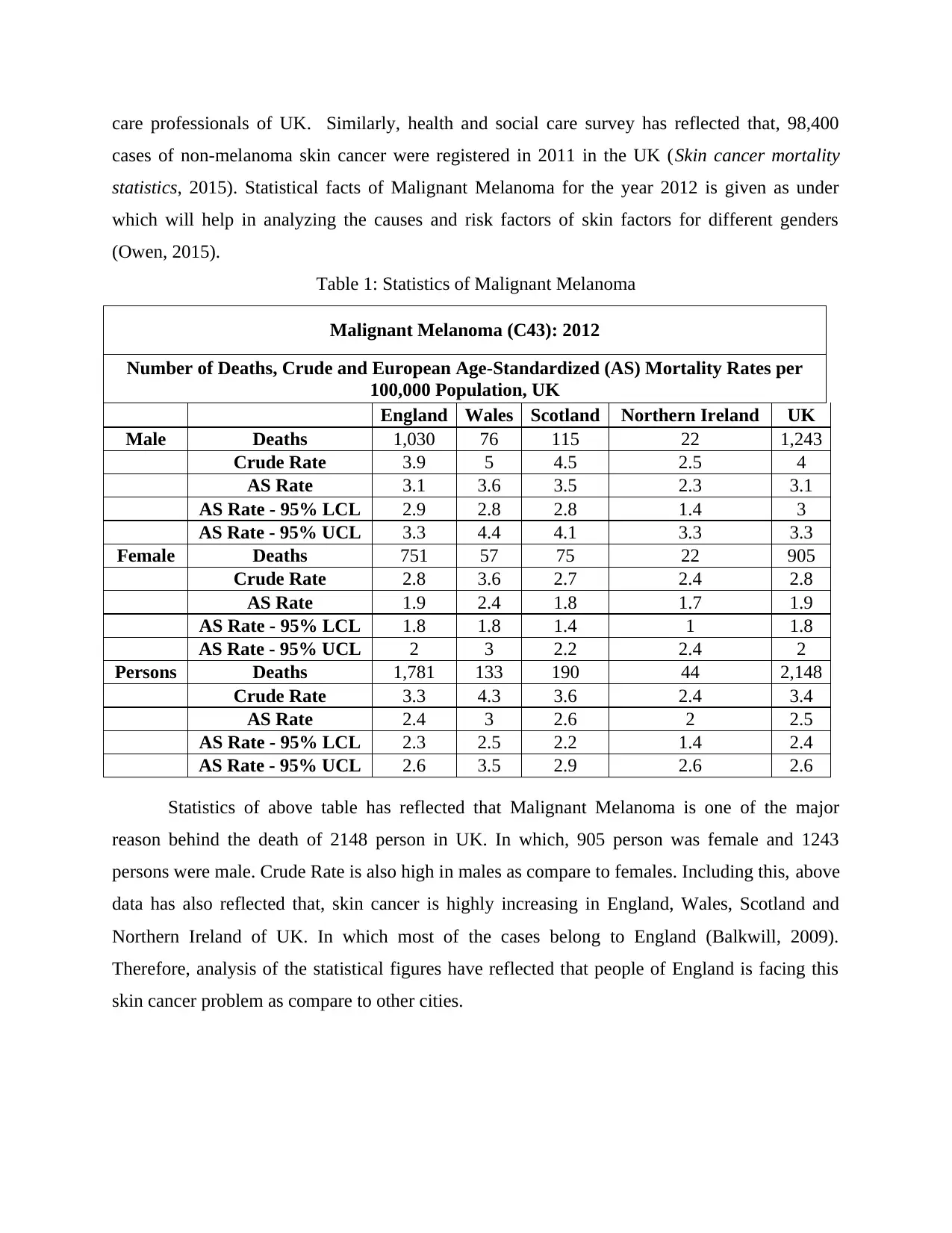
care professionals of UK. Similarly, health and social care survey has reflected that, 98,400
cases of non-melanoma skin cancer were registered in 2011 in the UK (Skin cancer mortality
statistics, 2015). Statistical facts of Malignant Melanoma for the year 2012 is given as under
which will help in analyzing the causes and risk factors of skin factors for different genders
(Owen, 2015).
Table 1: Statistics of Malignant Melanoma
Malignant Melanoma (C43): 2012
Number of Deaths, Crude and European Age-Standardized (AS) Mortality Rates per
100,000 Population, UK
England Wales Scotland Northern Ireland UK
Male Deaths 1,030 76 115 22 1,243
Crude Rate 3.9 5 4.5 2.5 4
AS Rate 3.1 3.6 3.5 2.3 3.1
AS Rate - 95% LCL 2.9 2.8 2.8 1.4 3
AS Rate - 95% UCL 3.3 4.4 4.1 3.3 3.3
Female Deaths 751 57 75 22 905
Crude Rate 2.8 3.6 2.7 2.4 2.8
AS Rate 1.9 2.4 1.8 1.7 1.9
AS Rate - 95% LCL 1.8 1.8 1.4 1 1.8
AS Rate - 95% UCL 2 3 2.2 2.4 2
Persons Deaths 1,781 133 190 44 2,148
Crude Rate 3.3 4.3 3.6 2.4 3.4
AS Rate 2.4 3 2.6 2 2.5
AS Rate - 95% LCL 2.3 2.5 2.2 1.4 2.4
AS Rate - 95% UCL 2.6 3.5 2.9 2.6 2.6
Statistics of above table has reflected that Malignant Melanoma is one of the major
reason behind the death of 2148 person in UK. In which, 905 person was female and 1243
persons were male. Crude Rate is also high in males as compare to females. Including this, above
data has also reflected that, skin cancer is highly increasing in England, Wales, Scotland and
Northern Ireland of UK. In which most of the cases belong to England (Balkwill, 2009).
Therefore, analysis of the statistical figures have reflected that people of England is facing this
skin cancer problem as compare to other cities.
cases of non-melanoma skin cancer were registered in 2011 in the UK (Skin cancer mortality
statistics, 2015). Statistical facts of Malignant Melanoma for the year 2012 is given as under
which will help in analyzing the causes and risk factors of skin factors for different genders
(Owen, 2015).
Table 1: Statistics of Malignant Melanoma
Malignant Melanoma (C43): 2012
Number of Deaths, Crude and European Age-Standardized (AS) Mortality Rates per
100,000 Population, UK
England Wales Scotland Northern Ireland UK
Male Deaths 1,030 76 115 22 1,243
Crude Rate 3.9 5 4.5 2.5 4
AS Rate 3.1 3.6 3.5 2.3 3.1
AS Rate - 95% LCL 2.9 2.8 2.8 1.4 3
AS Rate - 95% UCL 3.3 4.4 4.1 3.3 3.3
Female Deaths 751 57 75 22 905
Crude Rate 2.8 3.6 2.7 2.4 2.8
AS Rate 1.9 2.4 1.8 1.7 1.9
AS Rate - 95% LCL 1.8 1.8 1.4 1 1.8
AS Rate - 95% UCL 2 3 2.2 2.4 2
Persons Deaths 1,781 133 190 44 2,148
Crude Rate 3.3 4.3 3.6 2.4 3.4
AS Rate 2.4 3 2.6 2 2.5
AS Rate - 95% LCL 2.3 2.5 2.2 1.4 2.4
AS Rate - 95% UCL 2.6 3.5 2.9 2.6 2.6
Statistics of above table has reflected that Malignant Melanoma is one of the major
reason behind the death of 2148 person in UK. In which, 905 person was female and 1243
persons were male. Crude Rate is also high in males as compare to females. Including this, above
data has also reflected that, skin cancer is highly increasing in England, Wales, Scotland and
Northern Ireland of UK. In which most of the cases belong to England (Balkwill, 2009).
Therefore, analysis of the statistical figures have reflected that people of England is facing this
skin cancer problem as compare to other cities.
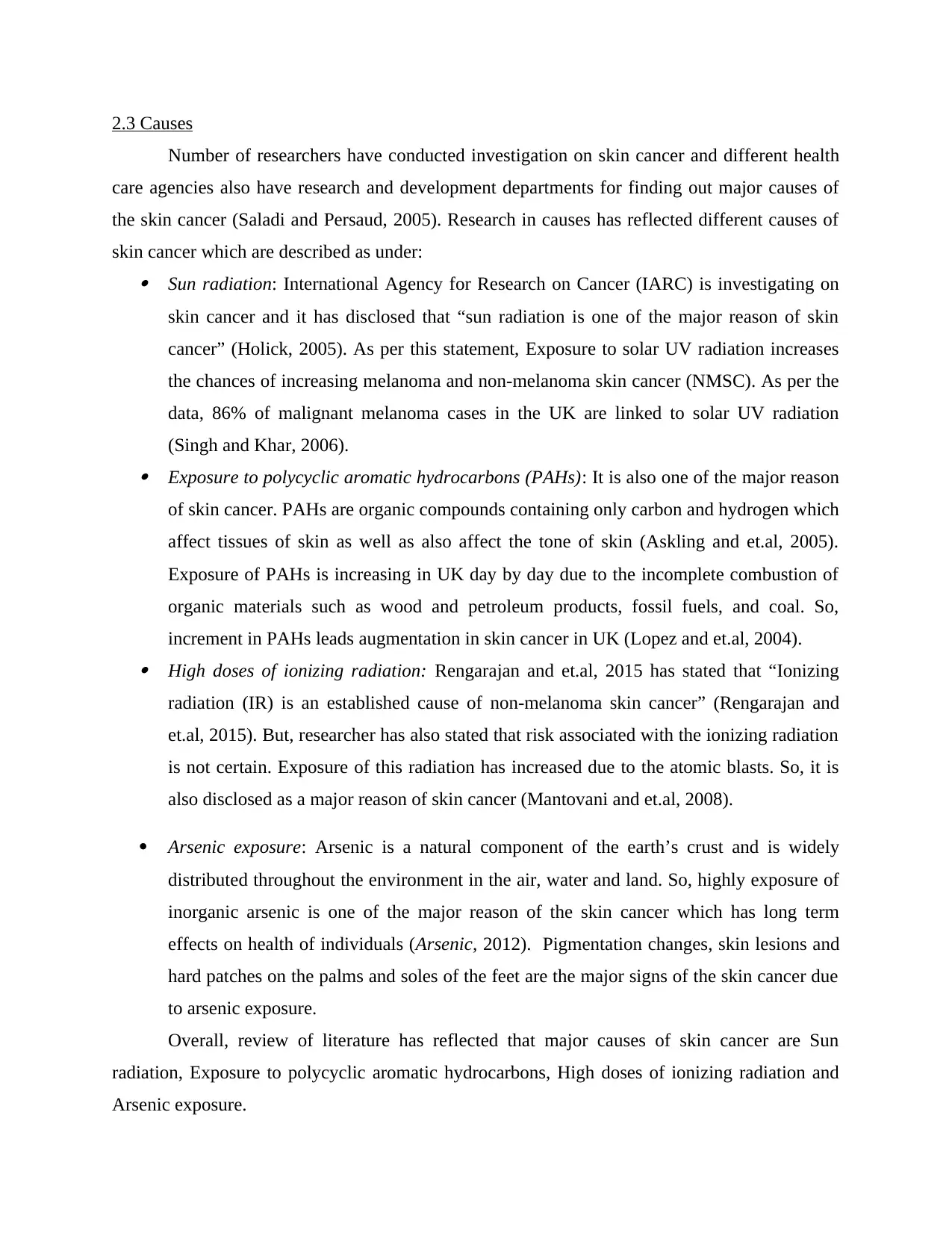
2.3 Causes
Number of researchers have conducted investigation on skin cancer and different health
care agencies also have research and development departments for finding out major causes of
the skin cancer (Saladi and Persaud, 2005). Research in causes has reflected different causes of
skin cancer which are described as under: Sun radiation: International Agency for Research on Cancer (IARC) is investigating on
skin cancer and it has disclosed that “sun radiation is one of the major reason of skin
cancer” (Holick, 2005). As per this statement, Exposure to solar UV radiation increases
the chances of increasing melanoma and non-melanoma skin cancer (NMSC). As per the
data, 86% of malignant melanoma cases in the UK are linked to solar UV radiation
(Singh and Khar, 2006). Exposure to polycyclic aromatic hydrocarbons (PAHs): It is also one of the major reason
of skin cancer. PAHs are organic compounds containing only carbon and hydrogen which
affect tissues of skin as well as also affect the tone of skin (Askling and et.al, 2005).
Exposure of PAHs is increasing in UK day by day due to the incomplete combustion of
organic materials such as wood and petroleum products, fossil fuels, and coal. So,
increment in PAHs leads augmentation in skin cancer in UK (Lopez and et.al, 2004). High doses of ionizing radiation: Rengarajan and et.al, 2015 has stated that “Ionizing
radiation (IR) is an established cause of non-melanoma skin cancer” (Rengarajan and
et.al, 2015). But, researcher has also stated that risk associated with the ionizing radiation
is not certain. Exposure of this radiation has increased due to the atomic blasts. So, it is
also disclosed as a major reason of skin cancer (Mantovani and et.al, 2008).
Arsenic exposure: Arsenic is a natural component of the earth’s crust and is widely
distributed throughout the environment in the air, water and land. So, highly exposure of
inorganic arsenic is one of the major reason of the skin cancer which has long term
effects on health of individuals (Arsenic, 2012). Pigmentation changes, skin lesions and
hard patches on the palms and soles of the feet are the major signs of the skin cancer due
to arsenic exposure.
Overall, review of literature has reflected that major causes of skin cancer are Sun
radiation, Exposure to polycyclic aromatic hydrocarbons, High doses of ionizing radiation and
Arsenic exposure.
Number of researchers have conducted investigation on skin cancer and different health
care agencies also have research and development departments for finding out major causes of
the skin cancer (Saladi and Persaud, 2005). Research in causes has reflected different causes of
skin cancer which are described as under: Sun radiation: International Agency for Research on Cancer (IARC) is investigating on
skin cancer and it has disclosed that “sun radiation is one of the major reason of skin
cancer” (Holick, 2005). As per this statement, Exposure to solar UV radiation increases
the chances of increasing melanoma and non-melanoma skin cancer (NMSC). As per the
data, 86% of malignant melanoma cases in the UK are linked to solar UV radiation
(Singh and Khar, 2006). Exposure to polycyclic aromatic hydrocarbons (PAHs): It is also one of the major reason
of skin cancer. PAHs are organic compounds containing only carbon and hydrogen which
affect tissues of skin as well as also affect the tone of skin (Askling and et.al, 2005).
Exposure of PAHs is increasing in UK day by day due to the incomplete combustion of
organic materials such as wood and petroleum products, fossil fuels, and coal. So,
increment in PAHs leads augmentation in skin cancer in UK (Lopez and et.al, 2004). High doses of ionizing radiation: Rengarajan and et.al, 2015 has stated that “Ionizing
radiation (IR) is an established cause of non-melanoma skin cancer” (Rengarajan and
et.al, 2015). But, researcher has also stated that risk associated with the ionizing radiation
is not certain. Exposure of this radiation has increased due to the atomic blasts. So, it is
also disclosed as a major reason of skin cancer (Mantovani and et.al, 2008).
Arsenic exposure: Arsenic is a natural component of the earth’s crust and is widely
distributed throughout the environment in the air, water and land. So, highly exposure of
inorganic arsenic is one of the major reason of the skin cancer which has long term
effects on health of individuals (Arsenic, 2012). Pigmentation changes, skin lesions and
hard patches on the palms and soles of the feet are the major signs of the skin cancer due
to arsenic exposure.
Overall, review of literature has reflected that major causes of skin cancer are Sun
radiation, Exposure to polycyclic aromatic hydrocarbons, High doses of ionizing radiation and
Arsenic exposure.
⊘ This is a preview!⊘
Do you want full access?
Subscribe today to unlock all pages.

Trusted by 1+ million students worldwide
1 out of 26
Related Documents
Your All-in-One AI-Powered Toolkit for Academic Success.
+13062052269
info@desklib.com
Available 24*7 on WhatsApp / Email
![[object Object]](/_next/static/media/star-bottom.7253800d.svg)
Unlock your academic potential
Copyright © 2020–2025 A2Z Services. All Rights Reserved. Developed and managed by ZUCOL.





